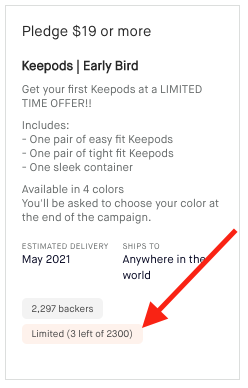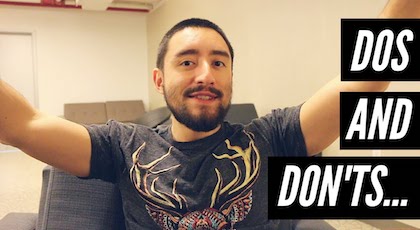Here’s the deal — driving traffic to your Kickstarter campaign page is great and all; but the traffic itself doesn’t lead to a wildly successful fundraiser.
Conversions do.
With this in mind, it’s important to optimize your campaign page for conversions through tried and tested practices.
In this article, we’ll be taking you through some key elements of your page to ensure that you’re enticing backers to buy, not just peruse.
Let’s discover how to make some sales and smash your funding goal!
Understand Backer Psychology
I’ve seen plenty of awesome, innovative products fall completely flat on Kickstarter.
This is usually due to one common mistake: a misunderstanding of backer psychology.
In the modern marketplace, people buy with emotion rather than logic. You could have the perfect product — great features, high quality materials, a superior build, the whole nine yards — but I’ll let you in on a little secret: these things will not provoke someone to buy.
You have to cultivate an emotion within your backers, whether that be humor, curiosity, anxiety, excitement, or something else. It doesn’t entirely matter what emotion you evoke, but you must work to get a consumer in an emotional state.
This is usually done through what we call the “hook” in your pitch video — the most important element of any campaign. Within the first 10-15 seconds, you want to get a potential backer to feel something, priming them for a buying decision.
Once you’ve cultivated that emotional state, then you can start delivering that logical information that justifies their buying decision.
Research shows that 95% of buying decisions are made with the subconscious mind that is responsible for our emotions. Target that subconscious instinct with an emotional appeal, and you’ll be on a fast track to seeing a hoard of backers that are eager to buy your product.
Building Desirable Reward Tiers
The building of must-have reward tiers is an indispensable element to any conversion-optimized Kickstarter campaign.
When structuring your rewards for buying decisions, try to hit the following guidelines:
- Popular Price Points: Ensure that your rewards pricing is right around market standards. If your product is particularly expensive, you should also brainstorm less expensive reward tiers to entice backers that want to support your mission — even if it’s just a $5 tier. Every dollar counts!
- Keep Things Simple: For art campaigns, there is an opportunity to expand rewards into double-digit tiers. But for product campaigns, it’s best to keep things streamlined. Consider offering 5-8 reward tiers to avoid overwhelming the consumer with overchoice.
- Utilize Reward Quotas: On Kickstarter, you have the option to display the number of items left on reward tiers. For example, if you were offering a 30% off early bird discount, you could have a countdown that says something like: ‘6 of 100 items left.’ This creates urgency in the buyer, increasing the chances that they’ll make a buying decision quickly so as not to miss out on a cheaper price. See this example:

- Up-sell With Add-ons: After somebody selects a reward tier, you can offer add-ons to produce a larger purchase. Consider add-ons that enhance your product in some way, making the buyer feel like they need them for the full experience of your offering.
- Exclusive Rewards: Offer backers a chance at a reward that will never be available again. This includes e-commerce or Indiegogo InDemand. The Kickstarter community loves feeling like they’re “in” on a cutting-edge secret!
Less Text is the Best Text
As a copywriter myself, this pains me a little bit. But in the digital age, attention spans are ridiculously short, and big blocks of text explaining your product is a sure-fire recipe for a click-away.
Make it as easy as possible for your consumer to understand your product offering through the use of:
- Images, gifs, and graphics
- Short supplemental videos
- Catchy headlines, subheadlines, and bullet points
This can be a challenge for creators on a tight budget, as the written copy is the easiest, cheapest marketing material to produce.
But investing in high-quality creatives up-front will lead to more conversions, and ultimately, a larger fundraise. So if you have the capabilities, cut back on the text as much as possible, utilizing copy in a capacity that is digestible for the scrolling consumer.
Clearly Identify Problem and Solution
Kickstarter is all about innovation. It’s about bringing new products to the market that solve problems — whether the consumer knows that problem exists or not.
In your campaign video, supporting messaging, and even in the title and subtitle, if possible, you should clearly outline a problem and how your product is a unique solution.
You can think of it this way:
Problem: Your opportunity to create that emotional response in a potential buyer. How is this problem negatively impacting their lives? What are the consequences of this problem? How should they feel about the havoc this problem is wreaking upon society?
Solution: Your chance to solve that problem. The consumer should think to themselves: What a relief! Do everything in your power to convince them that this product will change their lives for the better.
Keep in mind that your ‘solution’ element should also include that logical justification we talked about. It should prove that the product actually works, reveal some highlighted benefits of the product, and be backed with research!
Key Takeaways: Conversions are King
While driving traffic to your campaign page is important, that traffic means nothing if those people don’t show up to actually buy.
By following the steps listed above, you can optimize your “Kickstarter Sales Page” to attract a mass of backers that are eager to make a purchase.
Here at CrowdCrux, we specialize in driving qualified traffic and building campaign pages that convert. If you want assistance from an expert team specialized in Kickstarter marketing, it’s time to book a coaching call with the founder of CrowdCrux Salvador Briggman.
Not ready for personalized coaching just yet?
No problem. We’re committed to providing you with the educational resources you need to succeed. Check ‘em out:
- Book: The Kickstarter Launch Formula
- Founder Salvador Briggman’s Youtube Channel
- The Crowdfunding Demystified Podcast
- Bookmark the CrowdCrux blog (you’re here right now!)
- The CrowdCrux weekly newsletter
We hope that this article has been helpful for you. We’re excited to see what you come up with for your campaign page — get ready to see some conversions!









